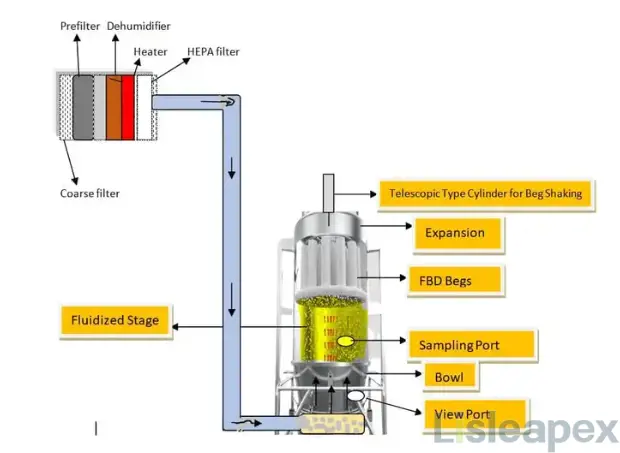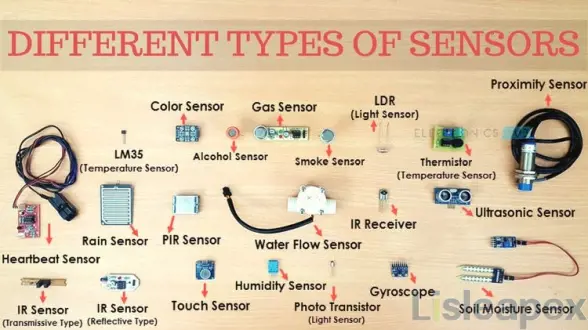What is Fluidized Bed Dryer (FBD)
A Fluidized Bed Dryer (FBD) is a type of equipment used in various industries for drying granular materials, powders, or particles. It operates on the principle of fluidization, where a gas (usually air) is passed through a bed of solid particles at a controlled velocity.

The basic setup involves a chamber or container that holds the solid particles to be dried. Air or gas is then forced through the bottom of this chamber via a perforated plate or distributor. As the gas passes through the bed of particles, it creates enough upward force to suspend and fluidize the particles, making them behave like a fluid.
During fluidization, the individual particles in the bed become buoyant and move freely, creating a state similar to boiling liquid. This movement enhances the contact between the drying medium (gas) and the solid particles, facilitating efficient heat and mass transfer.
The heat required for drying is introduced into the system by the hot air or gas flowing through the bed. As the fluidized particles come into contact with the heated gas, moisture or solvents evaporate from the surface of the particles, effectively drying them.
#1 Working of Fluidized Bed Dryer
Learn how FBD works step by step:
Step 1: Loading the Fluidized Bed Dryer
The initial phase involves introducing a fresh batch of wet granules into the product chamber. Employing negative pressure feeding, materials can be drawn from the high shear mixer chamber through a feeding tube, effectively loading the dryer with the desired material.
Step 2: Activating the Air Inlet (Intake)
The blower unit is activated from the control panel. Once operational, the blower draws air continuously from the Air Handling Unit (AHU), channeling it into the tower through the lower plenum.
Step 3: Initiating Fluidization
The inlet air is propelled upwards through the static powder bed. As the air velocity escalates, the space between powder particles increases until the particles are suspended in a fluidized bed. This fluidization process typically progresses through stages—starting with smooth fluidization, followed by bubbling fluidization, turbulent fluidization, and culminating in fast fluidization.
Step 4: Progressing through Drying Stages
The drying process unfolds in distinct stages until reaching the targeted endpoint, where the moisture level in the solid particles equals or falls below 1%:
Stage 5: Preheating
Initially, the wet particles are suspended within the hot and dry air stream. Moisture on the particle surfaces evaporates as heat permeates through the particles (via conventional heating). Initially, the drying rate is moderate as the particles gradually absorb more heat.
During this phase, the moisture loss remains relatively low. However, the temperature of the bed steadily rises, setting the stage for subsequent drying stages.
#2 Fluidized Bed Dryer Uses and Application
Fluidized Bed Dryers (FBDs) find extensive use across various industries due to their efficiency, versatility, and ability to handle a wide range of materials. Here are some common applications:
Pharmaceutical Industry
- Drying Granules: FBDs are extensively used to dry wet granules produced during pharmaceutical manufacturing processes, ensuring precise control over moisture content.
- Coating and Drying Tablets: They are employed in tablet coating processes, providing uniform drying after the coating application.
Food Industry
- Drying Food Products: Used for drying food ingredients, such as grains, fruits, vegetables, and powders, while maintaining their quality and preserving nutritional value.
- Dehydrating Food: FBDs are used in dehydrating processes for products like instant coffee, milk powder, and more.
Chemical Industry
- Drying Chemicals and Powders: Used for drying various chemical substances, including pigments, fertilizers, and catalysts.
- Polymer Drying: Employed in the polymer industry to dry polymer beads or pellets.
Agricultural Industry
- Drying Agricultural Products: Used to dry crops such as grains, seeds, and herbs, preserving them for storage or processing.
Environmental Applications
- Sludge Drying: Applied in wastewater treatment plants to dry sludge, reducing volume and facilitating disposal or reuse.
Other Industries
- Mineral Processing: FBDs are used for drying minerals, ores, and aggregates.
- Drying in Research and Development: Applied in laboratories and research settings for small-scale drying processes and experimentation.
#3 Fluidized Bed Dryer Advantages and Disadvantages
Let’s explore the advantages and limitations of FBD,
Advantages:
- Uniform Drying: FBDs ensure even drying throughout the material, preventing hot spots and ensuring consistent moisture removal.
- Gentle on Materials: Ideal for drying delicate materials as the fluidized state minimizes particle attrition or damage during the drying process.
- High Efficiency: Compared to conventional dryers, FBDs typically have faster drying times and are more energy-efficient due to the enhanced heat and mass transfer between the drying medium and particles.
- Controlled Drying Conditions: Parameters like temperature, airflow, and residence time can be controlled, allowing precise adjustments for different materials and drying requirements.
- Versatility: FBDs can handle a wide range of materials, from fine powders to granules, making them applicable across various industries like pharmaceuticals, food processing, chemicals, and more.
Disadvantages:
- Particle Size Requirements: Some FBDs might have limitations regarding the particle size for efficient fluidization. This can restrict the types of materials that can be effectively dried.
- Potential Particle Entrainment: If not properly controlled, smaller particles may be carried away by the fluidizing gas, leading to product loss or decreased efficiency.
- Initial Investment and Maintenance: FBDs often require a higher initial investment compared to some conventional drying systems. Additionally, regular maintenance is crucial to ensure optimal performance.
- Dust and Emission Control: Handling fine powders or particles in FBDs can lead to challenges in managing dust and emissions, requiring additional control systems for environmental compliance.
- Complexity in Operation: While FBDs offer precise control, their operation might require skilled personnel to manage and optimize the drying process effectively.
How Many Sensors in FBD
Sensors play a crucial role in monitoring and controlling various parameters within a Fluidized Bed Dryer (FBD) to ensure efficient and effective drying processes. Some key sensors commonly used in FBDs include:

Temperature Sensors: These sensors monitor the temperature within the bed, the inlet and outlet air temperatures, and sometimes the temperature of the material being dried. They ensure that the drying temperature remains within the specified range to prevent overheating or inadequate drying.
Pressure Sensors: Pressure sensors measure the pressure at different points within the dryer. They help in controlling the air pressure, ensuring proper fluidization of the bed, and maintaining the desired airflow rate through the bed of material.
Moisture Sensors: These sensors are used to measure the moisture content of the material being dried. They provide feedback to control systems to adjust drying parameters and help determine the endpoint of the drying process.
Level Sensors: Level sensors monitor the level of material within the FBD, ensuring that the bed remains within the optimal range for efficient fluidization and drying.
Flow Sensors: These sensors measure the flow rate of the drying medium (usually air) entering and exiting the FBD. They help maintain a consistent airflow, critical for proper fluidization and effective drying.
Particle Size Sensors: In some cases, sensors are employed to monitor the particle size distribution within the bed. This information can be used to optimize the fluidization process and ensure uniform drying.
Vibration Sensors: Vibration sensors may be used to detect irregularities or changes in the fluidized bed, helping in identifying issues like uneven distribution of particles or potential equipment malfunctions.
These sensors are often integrated into the control systems of the FBD, providing real-time data that enables automated adjustments to maintain optimal drying conditions. Monitoring these parameters ensures efficient drying, minimizes energy consumption, and helps maintain product quality and consistency.
Other sensors in FBD
Oxygen Sensors: Oxygen sensors monitor the oxygen levels within the drying chamber. This is crucial for certain drying processes that require specific oxygen levels, such as in particular chemical reactions or oxygen-sensitive materials.
Dust Sensors: These sensors monitor the dust levels within the drying chamber. In industries that demand low-dust environments, such as pharmaceuticals, monitoring and controlling dust levels are critical.
Current and Voltage Sensors: Used to monitor the status of the electrical system controlling motors or heating elements in the dryer. They ensure proper operation and prevent overload or faults.
Leakage Sensors: They help detect any potential electrical leakage or faults, ensuring the safe operation of the drying equipment.
Gas Composition Sensors: In certain cases, it's necessary to monitor the composition of gases within the drying chamber, such as specific gas concentrations or potential hazardous gas emissions.
In essence, sensors are integral components in FBDs, providing the necessary data for control systems to regulate and optimize the drying process. Their role extends from ensuring efficient drying and product quality to enhancing safety and enabling automated operation.
FAQ
-
How do sensors improve the efficiency of Fluidized Bed Dryers?
Sensors provide real-time data on various parameters crucial for the drying process. This data allows for precise control and optimization of drying conditions, enhancing efficiency and ensuring product quality.
-
What role do pressure sensors play in FBDs?
Pressure sensors monitor the pressure conditions within the FBD chamber. They help ensure the proper fluidization of the bed by maintaining the required air pressure for effective drying.
-
How are temperature sensors used in FBDs?
Temperature sensors are vital in monitoring and controlling the temperature within the fluidized bed. They provide feedback to regulate heating elements or airflow to maintain the desired drying temperature.
-
What types of sensors are commonly used in Fluidized Bed Dryers (FBDs)?
Several types of sensors find applications in FBDs, including temperature sensors (thermocouples or RTDs), pressure sensors, humidity sensors, flow sensors, level sensors, and sometimes gas concentration sensors, depending on specific process requirements.
Stay updated with Lisleapex by signing up for the newsletter


 Congratulations On Your Successful Submission
Congratulations On Your Successful Submission
 Submission Failure
Submission Failure